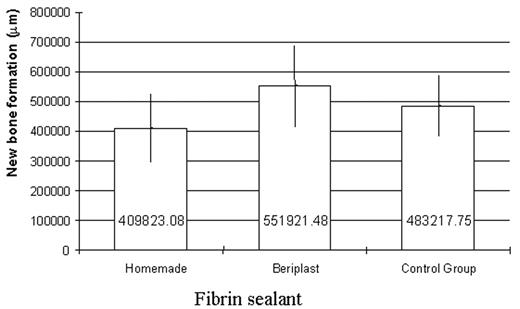Abstract
The beneficial aspects of fibrin sealants for soft tissues are well documented, but studies of their direct influence on bone healing and their effectiveness in augmenting bone graft healing have produced conflicting results. The aim of this study was to evaluate the influence of fibrin sealants (FS) in the alveolar bone healing process during a period of up to 28 days. Seventy-five Wistar rats were submitted to a superior incisor extraction after intramuscular anesthesia (kentamine chloridrate 10% – 10mg/kg and tiazina chloridrate-5mg/kg). The rats were divided into tree different groups and the sealants were introduced into the alveolar bone. The first group (25) received human homemade fibrin glue, the second group (25) FS associated to factor XIII and aprotinin (Beriplast; Aventis-Beringher) and the third group (25) was the control. Animals were sacrificed by prolonged diethyl inhalation on days 7, 14 and 28 after surgery. Animal craniums were dissected and submitted to a decalcification, and preparated for H&E light microscopy. The morphometric study was performed by means of an interactive computerized image analysis system KS400 (Zeiss, Jena). New bone formation was carefully delimited in four different alveolar regions (apical, two middle areas and cervical) of each specimen. The data were statistically analyzed using multiple regression, ANOVA and Tukey test. Results showed that the amount of alveolar bone formation (μm) in the control group and commercial sealant was statistically similar. However, alveolus receiving homemade sealant presented less amount of new bone formation comparing to commercial sealant and control group (p=0.0034) (figure 1). The present study demonstrated that homemade fibrin sealant delays osteogenic formation. Commercial sealant did not improve alveolar repair however, the amount of new bone formation was slightly higher comparing to the control, probably due to the factor XIII present in this sealant.
Author notes
Corresponding author


This feature is available to Subscribers Only
Sign In or Create an Account Close Modal